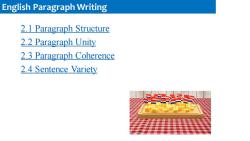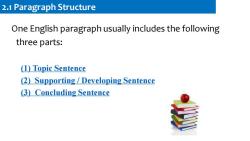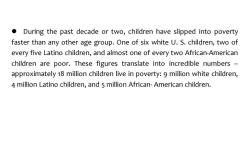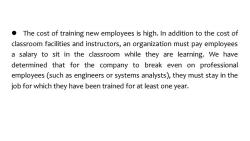《大学英语读写》课程教学资源(A)Ⅱ_大学英语读写(A)Ⅱ_Book3.Unit3.English paragraph writing

EnglishParagraphWriting2.1 Paragraph Structure2.2 Paragraph Unity2.3 Paragraph Coherence2.4 Sentence Variety
English Paragraph Writing 2.1 Paragraph Structure 2.2 Paragraph Unity 2.3 Paragraph Coherence 2.4 Sentence Variety

2.1ParagraphStructureOne English paragraph usually includes the followingthree parts:(l)TopicSentence(2)Supporting/DevelopingSentence(3)ConcludingSentence
2.1 Paragraph Structure One English paragraph usually includes the following three parts: (1) Topic Sentence (2) Supporting / Developing Sentence (3) Concluding Sentence

Paragraph Structure Model>Topic SentenceSupporting Sentence 1Supporting Sentence22Supporting Sentence23Supporting Sentence 4>Concluding Sentence
Paragraph Structure Model ➢Topic Sentence ⚫ Supporting Sentence 1 ⚫ Supporting Sentence 2 ⚫ Supporting Sentence 3 ⚫ Supporting Sentence 4 ➢Concluding Sentence

HowtoWriteaGood TopicSentenceThreeessentialpoints:1.主题句必须是一个完整的句子2.由主题词和主题思想的表述两部分构成3.只是一种概括性的陈述而不提供具体的细节e.g. Gold, a precious metal, is prized for two importantcharacteristics
(1) How to Write a Good Topic Sentence Three essential points: 1.主题句必须是一个完整的句子 2.由主题词和主题思想的表述两部分构成 3.只是一种概括性的陈述而不提供具体的细节 e.g. Gold, a precious metal, is prized for two important characteristics

Whichisagoodtopicsentence?·Americanfoodis terrible:Americanfood is tasteless and greasy becauseAmericansusetoomanycanned,frozen,and prepackagedfoodsandbecauseeverythingis fried inoil or butter.· American food is tasteless and greasy
Which is a good topic sentence? • American food is terrible. • American food is tasteless and greasy because Americans use too many canned, frozen, and prepackaged foods and because everything is fried in oil or butter. • American food is tasteless and greasy

ActivityIdentifywhichisthetopicsentence:·Systolicpressurebetween14oand16o indicatesborderlinehypertension.: In the usual blood pressure reading, the systolic measurement is given first and isthehigherofthetwo.: Systolic pressure is taken when the heart is contracting to pump blood; diastolicpressure is taken when the heart is resting between beats.:Blood pressure measurement has two components:systolic and diastolic.: Normal blood pressure is a systolic measurement of 14o, and when the systolicpressureis16oorhigher,thenhypertensionexists
Activity Identify which is the topic sentence: • Systolic pressure between 140 and 160 indicates borderline hypertension. • In the usual blood pressure reading, the systolic measurement is given first and is the higher of the two. • Systolic pressure is taken when the heart is contracting to pump blood; diastolic pressure is taken when the heart is resting between beats. • Blood pressure measurement has two components: systolic and diastolic. • Normal blood pressure is a systolic measurement of 140, and when the systolic pressure is 160 or higher, then hypertension exists

PracticeRead each of the following paragraphs. If you find a topic sentence,underline it. if not, write one that sums up the paragraph's messageorstatesitspoint.Producers make more goods when prices are high, and consumersbuy more goods when prices are low. As prices go up, producers makemore goods because they can make more money for their goods. Asprices go down, consumers buy more goods because of the low prices.This shows us how changes in the prices of goods can cause changes inproductionandconsumption
Practice Read each of the following paragraphs. If you find a topic sentence, underline it. If not, write one that sums up the paragraph's message or states its point. ⚫ Producers make more goods when prices are high, and consumers buy more goods when prices are low. As prices go up, producers make more goods because they can make more money for their goods. As prices go down, consumers buy more goods because of the low prices. This shows us how changes in the prices of goods can cause changes in production and consumption

The bright child is patient. He can tolerate uncertainty and failure, and will keeptrying until he gets an answer. When all his experiments fail, he can even admit tohimself and others that for the time being he is not going to get an answer. This mayannoyhim,but hecanwait.Very often,hedoesnot wanttobe toldhowto do theproblem or solve thepuzzlehehas struggled with,becausehedoes not want to becheated out of the chance to figure it out for himself in the future.Not so the dullchild.He cannot stand uncertainty or failure.To him,an unanswered question is not achallenge or an opportunity, but a threat. If he can't find the answer quickly, it mustbegivento him,and quickly;andhemust have answersfor everything.Sucharethechildren of whom a second-grade teacher once said, "But my children like to havequestions for which there is only one answer." They did; and by a mysteriouscoincidence, so did she
⚫ The bright child is patient. He can tolerate uncertainty and failure, and will keep trying until he gets an answer. When all his experiments fail, he can even admit to himself and others that for the time being he is not going to get an answer. This may annoy him, but he can wait. Very often, he does not want to be told how to do the problem or solve the puzzle he has struggled with, because he does not want to be cheated out of the chance to figure it out for himself in the future. Not so the dull child. He cannot stand uncertainty or failure. To him, an unanswered question is not a challenge or an opportunity, but a threat. If he can't find the answer quickly, it must be given to him, and quickly; and he must have answers for everything. Such are the children of whom a second-grade teacher once said, "But my children like to have questions for which there is only one answer." They did; and by a mysterious coincidence, so did she

During the past decade or two, children have slipped into povertyfaster than any other age group. One of six white U. S. children, two ofevery five Latino children, and almost one of every two African-Americanchildren are poor. These figures translate into incredible numbers -approximately 18 million children live in poverty: 9 million white children,4 million Latino children, and 5 million African- American children
⚫ During the past decade or two, children have slipped into poverty faster than any other age group. One of six white U. S. children, two of every five Latino children, and almost one of every two African-American children are poor. These figures translate into incredible numbers - approximately 18 million children live in poverty: 9 million white children, 4 million Latino children, and 5 million African- American children

The cost of training new employees is high. In addition to the cost ofclassroom facilities and instructors,an organization must pay employeesa salary to sit in the classroom while they are learning. We havedetermined that for the company to break even on professionalemployees (such as engineers or systems analysts), they must stay in thejob forwhich they have beentrained forat least oneyear
⚫ The cost of training new employees is high. In addition to the cost of classroom facilities and instructors, an organization must pay employees a salary to sit in the classroom while they are learning. We have determined that for the company to break even on professional employees (such as engineers or systems analysts), they must stay in the job for which they have been trained for at least one year
按次数下载不扣除下载券;
注册用户24小时内重复下载只扣除一次;
顺序:VIP每日次数-->可用次数-->下载券;
- 《大学英语读写》课程教学资源(A)Ⅱ_大学英语读写(A)Ⅱ_Book3.Unit5A.text organization.pdf
- 《大学英语读写》课程教学资源(A)Ⅱ_大学英语读写(A)Ⅱ_Writing:English Paragraph Development.ppt
- 《大学英语读写》课程教学资源(A)Ⅱ_大学英语读写(A)Ⅱ_Book3.Unit6B.words to note.ppt
- 《大学英语读写》课程教学资源(A)Ⅱ_大学英语读写(A)Ⅱ_Book3.Unit6B.text organization1..ppt
- 《大学英语读写》课程教学资源(A)Ⅱ_大学英语读写(A)Ⅱ_Book3.Unit1A.words to note.ppt
- 《大学英语读写》课程教学资源(A)Ⅱ_大学英语读写(A)Ⅱ_Book3.Unit1A.Text.ppt
- 《大学英语读写》课程教学资源(A)Ⅱ_大学英语读写(A)Ⅱ_Book3.Unit1A.exercises.ppt
- 《大学英语读写》课程教学资源(A)Ⅱ_大学英语读写(A)Ⅱ_Book3.Unit1A.课堂讨论课文所用课件.ppt
- 《大学英语读写》课程教学资源(A)Ⅱ_大学英语读写(A)Ⅱ_Book3.Unit3A.exercises.ppt
- 《大学英语读写》课程教学资源(A)Ⅱ_大学英语读写(A)Ⅱ_Book3.Unit3.language in use.ppt
- 《大学英语读写》课程教学资源(A)Ⅱ_大学英语读写(A)Ⅱ_Book3.Unit5A.exercise.ppt
- 《大学英语读写》课程教学资源(A)Ⅱ_大学英语读写(A)Ⅱ_Book3.Unit5.language in use.ppt
- 《大学英语读写》课程教学资源(A)Ⅱ_大学英语读写(A)Ⅱ_Book3.Unit6B.exercises.ppt
- 《基础日语》课程教学课件(PPT讲稿)第16課 春節.ppt
- 《基础日语》课程教学课件(PPT讲稿)第17課 コンサート.ppt
- 《基础日语》课程教学课件(PPT讲稿)第18課 病気 ユニット1 診察.ppt
- 《基础日语》课程教学课件(PPT讲稿)第18課 病気 ユニット2 お見舞い.ppt
- 《基础日语》课程教学课件(PPT讲稿)第18課 病気 ユニット3 読解文 高橋さんの日記.ppt
- 《基础日语》课程教学课件(PPT讲稿)第19課 黄砂 ユニット1.pdf
- 《基础日语》课程教学课件(PPT讲稿)第19課 黄砂 ユニット2 家族からの電話.pdf
- 《大学英语读写》课程教学资源(A)Ⅱ_大学英语读写(A)Ⅱ_Book3.Unit3A.language points.ppt
- 《大学英语读写》课程教学资源(A)Ⅱ_大学英语读写(A)Ⅱ_Book3.Unit3A.text organization.ppt
- 《大学英语读写》课程教学资源(A)Ⅱ_大学英语读写(A)Ⅱ_Book3.Unit1.Writing1.ppt
- 《大学英语读写》课程教学资源(A)Ⅱ_大学英语读写(A)Ⅱ_Book3.Unit1A.language points.ppt
- 《大学英语读写》课程教学资源(A)Ⅱ_大学英语读写(A)Ⅱ_Book3.Unit8A.课文原文.ppt
- 《学科英语》课程教学资源(文献资料)预习阅读材料10.doc
- 《学科英语》课程教学资源(文献资料)预习阅读材料9.doc
- 《学科英语》课程教学资源(文献资料)预习阅读材料8.doc
- 《学科英语》课程教学资源(文献资料)预习阅读材料7.doc
- 《学科英语》课程教学资源(文献资料)预习阅读材料6.doc
- 《学科英语》课程教学资源(文献资料)预习阅读材料5.doc
- 《学科英语》课程教学资源(文献资料)预习阅读材料4.doc
- 《学科英语》课程教学资源(文献资料)预习阅读材料3.doc
- 《学科英语》课程教学资源(文献资料)预习阅读材料2.doc
- 《学科英语》课程教学资源(文献资料)预习阅读材料1.doc
- 《学科英语》课程教学资源(讲义)ACADEMIC WRITING ——- PART V . CONCLUSION(1).doc
- 《学科英语》课程教学资源(讲义)ACADEMIC WRITING ——- PART IV RESULTS.doc
- 《学科英语》课程教学资源(讲义)ACADEMIC WRITING - PART III.doc
- 《学科英语》课程教学资源(讲义)ACADEMIC WRITING - PART II.doc
- 《学科英语》课程教学资源(讲义)ACADEMIC WRITING.doc
